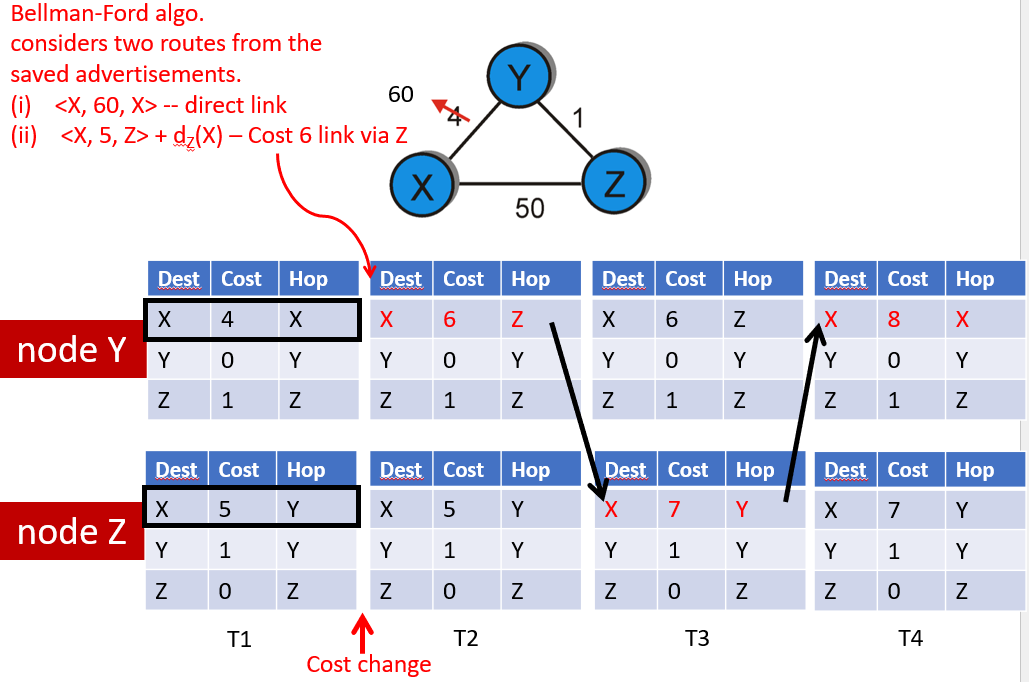- Each node constructs a vector containing the distances to all other nodes and distributes that vector to its immediate neighbors
- Starting assumption is that each node knows the cost of the link to each of its directly connected neighbors
- The NextHop column in the table below tells it which node to send packets to to get to the desired destination

Protocol
- Advertise: A router transmits its distance vector to each of its neighbors in a routing packet
- Two circumstances when a node sends out routing circumstances:
- Periodic: Automatically after some time
- Triggered: When an event makes a change to its routing table (e.g. link fail or new message from neighbor)
- Two circumstances when a node sends out routing circumstances:
- Each router receives and saves the most recently received distance vector from each of its neighbors
- Update: A router recalculates its distance vector when:
- It receives a distance vector from a neighbor containing different information than before, OR
- It discovers that a link to a neighbor has gone down or the cost has changed
For a worked out example, see the PowerPoint for lecture 3 (specifically, slides 36 onwards)
Algorithm
Uses Bellman-Ford algorithm (dynamic programming)
def distance(x, y):
min(distance(x, v) + distance(v, y) for v in neighbors(y))Key ideas:
- From time to time, each node sends its own distance vector estimate to its neighbors
- The neighbors then update their distance vectors using Bellman-Ford
- Under minor, natural conditions, the distance estimates converge to the actual least costs
Each node x does the following:
- Initialize
x - For every neighbor
y:D[x][y] = cost(x, y)- We don’t know about nodes that aren’t neighbors, so the cost to them is basically infinity at this point
- Send distance vector
D[x]to all neighbors - Loop forever:
- Wait until you receive a distance vector from some neighbor
w - For each node
y, update distance toyusing Bellman-Ford - If the distance to any of the neighbors was updated, send the new distance vector to all neighbors
- Wait until you receive a distance vector from some neighbor
Algorithm characteristics:
- Iterative, asynchronous
- Each local iteration caused by:
- Local link cost change
- Distance vector update message from neighbor
- Each local iteration caused by:
- Distributed
- Each node notifies neighbors only when distance vector changes
- Neighbors then notify their neighbors if necessary
- Each node notifies neighbors only when distance vector changes
Link failure and cost updates
- Node detects local link cost change
- Updates routing info, recalculates distance vector
- If distance vector changes, notify neighbors
If link fails:
- You can remove them from the routing table entirely
- Or you can keep them in the table but update cost to infinity
PowerPoint 3 (linked somewhere above) shows it step-by-step
Count-to-infinity problem
If the link cost increases, that can be problematic:
- The distance between Y and X should actually be 51 now
- But Y will think it’s 6
- Because the distance between Z and X is stored as 5
- And the distance between Y and Z is 1
- Then Z will update its distance to X to 7
- Then Y will update its distance to X to 8
- And so on, infinitely…

Some solutions to count-to-infinity problem:
- Have a small number for infinity, so at least it stops at some point
- In the Routing Information Protocol, the max number of hops is typically 15 or 16
- If a network is more than 15 hops away, it is considered unreachable
- This may work for smaller networks, but not larger networks
- Split horizon
- Tries to avoid loops while advertising (but doesn’t always work)
- Improves time to stabilize routing
- When a route sends a routing update to its neighbors, it does not send the routes it learned from each neighbor back to that neighbor
- So in the example above, since Z has route (X, 5, Y) in its table, it won’t send (X, 5) to Y because the distance 5 route to X passes through Y
- Poison reverse - stronger version of split horizon
- Advertise a bad route (set cost to infinity) rather than merely omit route
- Cons:
- Can significantly increase size of routing announcements
- PDF explaining difference between split horizon and poison reverse: https://www.cs.umd.edu/class/spring2024/cmsc417/course_materials/slides/4_DV_routingExamples.pdf
Limitations
- Assumes small networks
- Possibility of routing loops
- Has static and pre-determined link costs
- Link costs can actually change after the network starts up